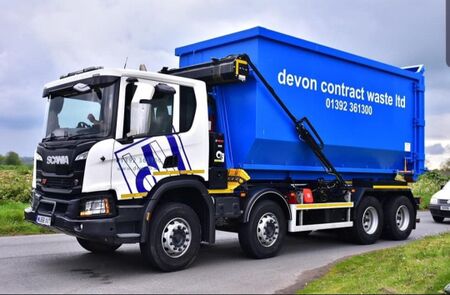Hooklift Lorry
A Hooklift Lorry is a type of lorry used to transport a large specialised Skip to and from a waste producers' premises. The process is to remove a full skip from a site when the waste producer has finished with it, and if the same empty Skip is required to be provided back to the site the process is often referred to as 'tip and return'. If a different Skip is used to replace the full skip the process is often referred to as an 'exchange'. The Hooklift Lorry can also be referred to as a Ro-Ro Lorry and Roll-on Roll-off Lorry.

Summary
A Hooklift Lorry is a type of lorry used to transport a large specialised Skip to and from a waste producers' premises. The process is to remove a full skip from a site when the waste producer has finished with it, and if a the same empty Skip is required to be provided back to the site the process is often referred to as 'tip and return'. If a different Skip is used to replace the full skip the process is often referred to as an 'exchange'. The Hooklift Lorry can also be referred to as a Ro-Ro Lorry and a Roll-on Roll-off Lorry.
Process
The skip has a 'bar' at the front which is used for lifting and pulling the skip onto the lorry. The lorry has an arm with a 'hook' on the end that is hydraulically powered such that the arm can pivot and move over the back of the lorry for the hook to locate on the bar of the skip (hence the name 'Hooklift'). Once engaged, the arm is reversed in motion to firstly draw the bin towards the lorry (the skip has small metal wheels at the opposite end of the skip to the bar) and then up and onto the lorry (see picture below). The arm then moves forward and the skip moves into the correct position on the lorry (with wheels on the lorry to allow the smooth movement of the skip) before being locked into place via a set of automatic fixings on the body of the lorry. The use of the wheels to roll the skip onto and off the body of the lorry is why it is often referred to as a 'Roll-on Roll-off' lorry (or 'Ro-Ro' for short).
If the lorry is moving a skip with no lid or top (an open bin/skip) which risks material blowing away during transit, there is a separate automatic 'sheeting system' operated via a separately driven arm that unrolls a sheet of fabric over the container from front to back.
During tipping the container doors are opened at the rear manually and the sheeting system is rolled back (if used), and the skip is fixed at the rear whilst the lifting arm then pushes the skip upwards to facilitate the material in the skip sliding out.
